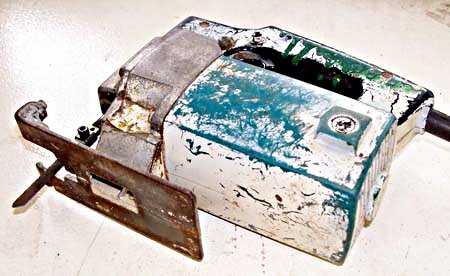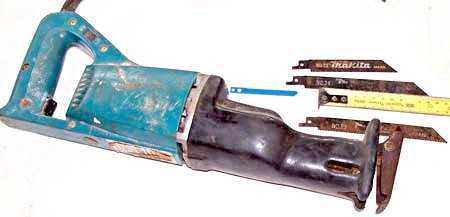 |
||||||||
Jig Saw, Recipro Saw, Sabre Saw
IntroductionJig saws are used mainly for cutting curves through a few different materials. Wood, up to say 50mm (2 ") thick, thin metal sheets, plastics etc. The action of the cutting blade is up through the material to the base of the saw. The teeth on the upstroke help to pull the base of the saw into firm contact with the work. This is the usual way of doing it. As it is in all powered saws, they would be dangerous otherwise. Some jig saws have a small light that comes on when you pull the trigger. A handy addition. Some models also come with an orbital function. To be honest, I have never used one, but the theory is that the orbital action allows a faster cut. All jig saws seem to come with a tilting fence. I can't remember ever using mine tilted. Tips for usingAs I wrote in the intro, a jig saw cuts on the up stroke.
I see that you can now buy jig saw blades that do in fact cut on the down stroke, specially for laminate. I don't know how good the are, I've not been game to try them. Every toothed saw ever made, works on the principle of the two surfaces, the work and the saw being pulled together by the cutting action. Pushing them apart sort of goes against the grain for me. (ha ha). If you have used one of these and they are good, let me know. In my page on making a temporary saw bench I show how I often knock up a bench for cutting ply etc. with my circular saw. If I have laminate sheets to cut, especially narrow strips and small pieces, I do the same with my Makita jig saw. Sort of like a poor man's band saw.
There is a neat fit all around the blade, the blade is cutting down through the face of the laminate, so the splinters, if any, are on the back. Magic. Sabre saw, recipro, reciprocating saw
Saber saws are just a lot bigger than a jig saw, with the same up and down action. They are not for cutting curves so much as cutting in hard to get at places. Like the jig saw they have a range of blades for different materials. I have used the one pictured for cutting off overhanging rafters and purlins with the roof sheeting still on, prior to us building on an extension. Also it is good for cutting off seized up nuts, where you don't want to make sparks with other tools. Not a common tool but maybe handy to hire for an odd job. There are some typical blades in the photo, and the small blue one is a jig saw blade for size comparison. .Not found it yet? Try this FAST SITE SEARCH or the whole web |
Hire Equipment  Furniture Fittings - Architectural Hardware - Electronic Locking Systems - Technical Hardware BuilderBill sponsorship Power tool related pages
|
|||||||
|
|
||||||||
|
Please Note! The information on this site is offered as a guide only! When we are talking about areas where building regulations or safety regulations could exist,the information here could be wrong for your area. It could be out of date! Regulations breed faster than rabbits! You must check your own local conditions. Copyright © Bill Bradley 2007-2012. All rights reserved. |
||||||||

